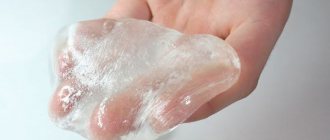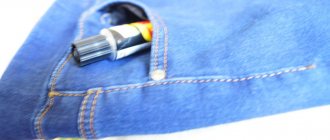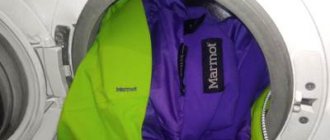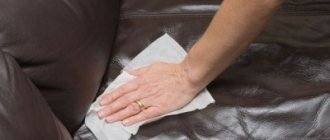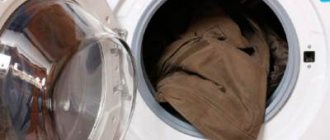It is a chemical reaction with glass. Glass is very chemically resistant, but it is afraid of silicate glue - sodium silicate. Of these chemicals, I only know hydrofluoric acid, but the chemistry there is completely different.
So never glue anything to glass with silicate glue. Although it will hold.
It’s unlikely with concrete, although I’m not a chemist. But it will probably react with sand from concrete - remember what glass is made from.
How to clean frying pans and heavily soiled pots? Modern detergents are good for everyone, but they are difficult to cope with a thick layer of carbon deposits on pans and pots. You will have to sweat a lot until you clean it to a shine. But there is a good old, but unfortunately almost forgotten way to do this without chemicals. Liquid glass is a practically harmless composition; its scope of application is quite wide. It is especially used in construction, as an additive to cement mortars. Such a solution is suitable for plaster; concrete with such a filling takes on good water-resistant qualities, which are so necessary when installing floors, when repairing wells, or even when priming in damp rooms. So, as before, he has no equal in cleaning dishes. Liquid glass for heavily soiled surfaces of dishes is used as follows:
The best way is boiling. The process is certainly long, but it is worth it. To do this, you need to take a large, wide pan or metal tank. Pour at least ten liters of water into it, add one liter of liquid glass to it. Place the tank on the fire and let it boil.
How to remove ceramic coating from a car?
Welcome to the kuzov/info blog!
In this short article we will figure out how to remove ceramic coating from a car body.
Ceramic coating is very hard and, unlike wax or sealant, can provide a reliable form of protection for a very long time. Over time, the protective coating slowly wears out, hydrophobicity and protective properties decrease. When the ceramic coating shows signs of wear, it must be removed to allow a new coating to be applied.
Most products work best on bare paintwork.
In addition to wear and tear of the old protective coating, removal of the ceramic layer may be necessary during body repairs and repainting of body panels. It should be noted that if you are going to repaint the car, you will need to wait at least 30 days after applying the paint and varnish before applying a new ceramic coating.
How to clean dishes
The mixture can clean soot from frying pans or cauldrons, and copes 100% with ordinary deposits on dishes.
Silicate can be replaced with PVA glue, and soda ash with regular soda, although the cleaning ability of the product will decrease somewhat.
Soaking
This method can be used to clean dishes that have turned yellow on the back side, spoons, forks, knives and pots that are smoked at the bottom. It is advisable to simultaneously place all contaminated kitchen utensils in a container of suitable volume. In the absence of large containers, a bath is used.
How difficult is it to remove a car's ceramic coating?
The hardness and strength of the ceramic coating is an advantage when it comes to car use, but it also poses a challenge when removing it. Regular or fine abrasive polishing and detergents have very little effect on the nanoceramic layer. Certain chemicals (especially non-alkaline ones) also have little effect on it. This makes the ceramic coating difficult to remove. However, this coating is not something super durable. Remember that this is just a thin film, although more durable than regular wax.
Various methods for removing ceramic coatings
There are several different ways to remove the coating. The steps listed below are based on the durability of the coating. In some cases, the manufacturer may be able to advise how best to remove the product. Some manufacturers have developed products specifically to remove their products.
Chemical removal
Although ceramic coating has very good chemical resistance to most chemicals, it is not very resistant to alkaline products. It should be noted that a sufficiently strong product can also damage the paint layer located under the protective coating.
High alkaline cleaners have a high pH level.
Solutions with a pH between eight and 14 are considered alkaline. High alkaline cleaners include sodium carbonate, sodium hydroxide and ammonia. For example, you can use a brake buster wheel cleaner with a car scrub (clay mitt). The success of removing ceramic coating using this method will depend on its type, thickness and age. One of the properties of a protective ceramic coating is its hydrophobic effect.
After chemical removal of the coating, this effect disappears. This is a sure sign that the “ceramics” has been removed. The photo on the left shows paintwork with a ceramic coating, the photo on the right shows after removing the protective coating. If you are using a cleaner that is not specifically designed to remove the nanoceramic layer, then first test it on a small, inconspicuous area of the body.
Removing ceramic coating with cleaning clay
This method involves the use of special detailing clay with a limited amount of wetting agent. Thus, the key to removing the remaining “ceramics” will be increased friction of the clay against the body. Cleaning clay usually won't remove ceramic coating alone, but if it's very worn, it may be an option.
Using cleaning clay is not the best or guaranteed way to remove “ceramics”; it is better to use it for its intended purpose, to prepare the surface for polishing.
Polishing
Polishing is the most reliable way to remove ceramic coating from a car body. The difficulty is that when polishing it is impossible to visually see whether the coating has been completely removed or not. You can test this point by first wiping the polished surface with isopropyl alcohol (to remove oils from the polish), then pouring water on it. Varnish without “ceramics” becomes non-hydrophobic, the surface will not repel water. The surface will become less slippery.
To remove ceramic coating by polishing, follow these steps.
If you are removing an old coating to apply a new one, it is important that after polishing the paint is completely cleaned and degreased before applying the new “ceramics”.
Source
Choosing a remedy
You should choose a cleaning agent for acrylic paint based on such factors as the type of surface, the number of layers applied, the adhesion of the paint to a specific material and the type of chemical composition. If you do not take these rules into account, you can easily damage clothing, glass, tiles or other surfaces.
Purchased
Among the purchased products that are created specifically for removing heels from acrylic, we can highlight the Prestige gel remover and universal cleaners. They are more effective, but before using one of them, you should carefully study the cleaning rules so as not to damage clothing or other surfaces on which paint has come in contact.
Folk
To make your own stain cleaner, you can use the following:
- vinegar;
- kerosene;
- Vanish;
- brushes and sponges;
- hot water;
- nail polish remover.
Traditional methods will be most effective if a person starts cleaning before the paint has time to dry. This especially applies to clothing. It is almost impossible to remove acrylic from some types of fabrics. If the stain dries out, even aggressive methods may be useless.
Liquid glass
Relatively recently, a new product from Japanese developers appeared on the car market - liquid glass. Advanced car enthusiasts have already managed to evaluate the product and feel the “wow effect” on their car. Today we will look at: what liquid glass for cars is, what are the advantages and disadvantages of the product, how to apply liquid glass and subsequently remove it.
What is liquid glass for cars and why is it needed?
Liquid glass for cars is used as a polish. When processing the body or the entire car, a transparent film is created that protects the car from minor damage, adds shine and newness. As car owners note, the color becomes brighter after polishing. In addition to the effect of restoring color and hiding minor defects, liquid glass reflects water and air.
There are several types of liquid glass:
The latter is the rarest, used as a thermostat. Most often, potassium is used for polishing, since potassium-based polishes have better water-repellent properties.
What is the difference between liquid glass, regular polish and nanoceramics
The advantage of using liquid glass over conventional polish lies in its comparative durability, hydrophobicity, preservation of the original color and hiding of small defects. For comparison, a wax polish lasts on a car up to 1 wash, a polymer polish lasts up to 4-5, and an abrasive polish is used in rare cases (for example, to remove glass). The glass will last on a car for up to 30 washes.
Nanoceramics and liquid glass are the main competitors in the automotive services market. Nanoceramics is an expensive material, but at the same time more durable. If liquid glass in the domestic climate lasts for 8 months (maximum a year), then nanoceramics manufacturers promise results for up to 3 years. When choosing between regular polish, ceramics and glass, preference should be given to the latter. Liquid glass is a confident middle ground between expensive ceramics and conventional coatings. Whatever you decide, the choice is yours.
How to dissolve liquid nails if they are dry
Any of us who have cleaned up the consequences of a renovation at least once in our lives have wondered how and with what to remove stains and blots from liquid nails. They inevitably appear even with careful work, and it is recommended to get rid of them immediately using a dry, clean cloth.
What to do if such unpleasant surprises remain after the repair? In addition, they get on clothes, which is doubly unpleasant. There is only one answer - follow the manufacturer's instructions on the packaging if the product is of high quality.
What are liquid nails, advantages and types.
This is a construction adhesive, which, unlike the usual one, contains fillers with small fractions, which presses the composition more tightly to the surface. The basis is synthetic rubber and polymers, and the filler is a special clay with high plasticity.
The composition acquires a white color when chalk or titanium dioxide is added as a filler. Acetone or toluene is used as a solvent. These substances are toxic and manufacturers refuse them.
- Neoprene is very toxic. They are based on organic solvents. The unpleasant smell after work lasts for several days. The composition retains its properties even at a temperature of -20 degrees.
- Water-based or acrylic. These are harmless, but are only suitable for gluing materials with porous surfaces. They cannot withstand freezing temperatures.
The advantage of such glue is that it does not violate the structure of the materials being glued, is not subject to corrosion, and does not collapse over time, but only gains strength.
Source
Pros and cons of car processing
pros
Minuses
Despite all the advantages of the procedure, there are a number of disadvantages. Among them:
So, you have weighed all the pros and cons of liquid glass for a car. Let us warn you once again, covering a car with liquid glass is a complicated procedure. In case of a small mistake, the result can be disastrous. If you are sure that you have sufficient skills to handle a car yourself, go ahead!
How to apply liquid glass to a car
Preparing the premises and materials
The processing area must be clean. No drafts, high humidity. The ideal temperature would be 10-40 degrees. Unfortunately, it will not be possible to treat the car in the fresh air. Winter cold and direct ultraviolet sun rays in summer can negatively affect the results.
Before you start treating your car with liquid glass, you need to purchase the following materials:
Tip: Liquid glass is often sold in stores along with some of the above items. It’s better not to skimp and take a product that includes the components necessary for processing.
What to do before polishing a car
Before applying the composition to the car, rid the car of all contaminants. If there is old polish, remove it. Then dry and remove grease from the car.
Before polishing, we recommend watching the video on how to apply liquid glass to a car. A visual process will be more clear, and some points can be re-read at any time in the instructions below.
Look for instructions in Russian for the polish you purchased. If there is one, we advise you to read it carefully before taking any action. Also note that it will take +/- 5 hours to fully polish your car. This is because each body part is processed separately and in several layers.
How to apply liquid glass correctly
So, how to cover a car with liquid glass:
Do the procedure for each part of the machine. After all manipulations, leave the car to dry for 5-6 hours. After successful polishing, do not wash the car for 1-2 weeks.
Tips for cleaning tiles for reuse
Before you start cleaning the tiles, you need to find out what solution was used to glue them:
- The cement composition penetrates firmly into the tile structure, and to remove it, chemical solutions are required. If you soak the tiles with cement residues in hydrochloric acid and leave for 10 hours, the glue will soften and can be easily removed with a metal spatula. Clean tiles must be rinsed under running water.
- The epoxy-based polymer composition is removed from the coating with solvents such as ethyl acetate or butyl acetate. Wet the back surface of the tile with the remaining adhesive with solvent and wait 20 minutes. The mixture on the tile under the influence of chemical components will become soft and can be easily removed with a metal spatula. This procedure can be repeated until complete cleansing.
- Liquid nails are an ideal building material for cladding, but it is difficult to remove dried glue from the surface. Liquid nails are removed from the tiles using a special remover or hot air from a hair dryer.
Professional tilers recommend laying tiles using dry adhesive mixtures (Ceresit CM 11, Knauf, Mastplix T-12, etc.). Such adhesives contain cement and polymers, thanks to which the tiles hold firmly, and it is difficult to remove the mortar after drying.
You can clean the tiles from tile adhesive for re-installation using the liquid cleaner “Metalin OF-C”, which, thanks to organic acids, breaks down the adhesive mass.
Attention! Often, after construction work, traces of silicone, sealant or grout remain on the tiles. For this purpose there is a cleaning agent ATLAS SZOP, which dissolves alkaline compounds. The liquid composition instantly reacts with the glue and quickly removes all stains.
How to remove liquid glass from a car
A car enthusiast has questions about how to wash off the composition from a car in case of unsuccessful polishing. If the procedure is carried out successfully and without flaws, then there is no need to remove liquid glass.
On the website of one of the liquid glass manufacturers they write that:
“Liquid glass can be removed using any polish with a fine abrasive.”
That is, to remove liquid glass from a car body, it is enough to polish it with an abrasive. As drivers write, this method is not a panacea. The abrasive will not be able to remove the composition from deep scratches. Plus, it wears out quickly and requires a lot of water in the process.
If the treatment of the car with liquid glass is unsuccessful, it will only be possible to partially remove it from the car. Therefore, think again, is the risk worth the money saved?
Source
What does mechanical work to remove stains involve?
Liquid glass can also be removed mechanically, but it should be borne in mind that it is quite labor-intensive and requires a lot of physical effort.
For mechanical cleaning it is advisable to use the following items:
- a razor blade (this is a good option due to the plasticity and sharpness of such an object);
- sharp knife;
- any other piercing or cutting instrument.
“Mechanics” should be resorted to when there is time for this and considerable enthusiasm for routine work. However, if using a “manual” method, without the use of chemicals, you can remove any contamination from porcelain tiles, then you can “deal with” liquid glass using the same principle. But you should be prepared that the old frozen “foci” of it are much more difficult to remove than fresh stains; you will definitely have to tinker with them.
In order to restore floor coverings, there are plenty of effective types of work, each of which brings certain results. Therefore, the owners of residential premises must always individually determine for themselves exactly how to “fight” liquid glass, which through negligence ends up on porcelain tiles and spoils its appearance and creates an uncomfortable family environment for everyday life.
How to clean liquid glass from a car
I just came up with an idea, maybe some kind of acid? vinegar? electrolyte maybe?
Try "Super Clean Glass" from TArtl Wax
Can this be purchased at an automotive chemical store?
Apparently it wasn’t a three-thousander, but some kind of acid! And he scratched the glass, now it will be so IMHO.
thank you, but if you haven’t wiped off the gasoline, I think it’s unlikely that a two-thousander will wipe off...
Something similar happens to me from time to time. You create problems for yourself, and then you become an asshole.
“Success is not final, failure is not fatal: what matters is the courage to continue.” Churchill.
Try acetone or Khaygirovsky carb cleaner, it is also very evil.
I tried carb cleaner and it doesn’t work, I’ll buy acetone today and try it...
Only acid is more aggressive than acetone. Try postage.
and yesterday I just bought the 3000th to clean the interior... so why is it so aggressive? If glass scratches, then what can it do to velor and plastic?
Take pure alcohol or “degreaser”, which is what automolars use, and there won’t be any problems. I myself got into the same situation the other day, I thought I was a bastard, but fortunately a fellow automolarist suggested it and the whole problem was solved at once!
Damn, I already rubbed it with alcohol... 2 Maxim 24, were there any smudges on the glass? I’ll try the “low fat”... but how can I ask for it in the store? what is the name of?
Yes, there were drips, I sprayed the car with it, the same thing, and at first I thought the paint was coming off. But I figured out the car quickly, took the car polish No. 1 and fixed everything, and wiped off the glass with degreaser. That's what it's called.
“Degreaser” is used by automolarists; they treat it with it just before painting the cars,
Not everyone is familiar with a material with such a seemingly absurd name as “liquid glass”. However, builders and those interested have known this phrase for a long time. It has been used for almost two centuries. Today I’ll tell you what kind of animal this is, and I’ll share with you tips on how to clean liquid glass.
How to wash your hands from fuel oil
Modern people are surrounded by a wide variety of mechanical devices. Therefore, no one is immune from contamination by greasy lubricants. Men are especially often concerned about the issue of removing fuel oil from their skin, because they are most often associated with the maintenance of equipment. But women and children can also get dirty with fuel oil. To get rid of it, you will need special or improvised means. It can be:
- specialized cleaning products for washing heavily soiled hands
- dishwashing detergents;
- chemicals for dry hand cleaning;
- White Spirit;
- washing powder;
- butter;
- margarine;
- eucalyptus oil;
- laundry soap;
- ammonia;
- petrol;
- car shampoo;
- soda;
- coffee grounds;
- berries;
- clay.
Depending on possibilities or personal convictions, it is permissible to use both chemical and traditional methods to remove fuel oil. The choice determines the intensity of contamination and the characteristics of the victim’s body.
Chemical methods
Chemicals are most often used to remove fuel oil. The drugs are reliable and effective. Contamination is quickly removed with effective chemical reagents. There are several options for using household chemicals.
According to the first method, to remove fuel oil, use washing powder or dishwashing detergent:
What is liquid glass
If you are a man and looked at the blog by chance, you don’t need to explain what it is. You yourself know: this is an aqueous alkaline solution of potassium silicate or sodium silicate. Practically, this is the same silicate glue. It is made from sand and soda at high temperatures, as well as using potassium or sodium compounds (potassium or sodium glass is obtained, respectively).
This material perfectly insulates heat and is able to withstand high temperatures, withstanding heat, frost and thawing. It is also often added to concrete to increase the waterproofing of the latter; such a duo will not be afraid of mold and mildew.
Also, this miracle product has very good adhesiveness, instantly connecting hard surfaces.
Ceiling tiles and linoleum are often placed on it, and pipes are sealed with its participation. Almost all masters use it at least once in their practice. Liquid glass often comes to the rescue in the garden: after pruning trees, it is used to “seal” the cut areas to prevent infection.
Top 3 special drugs
If improvised means are ineffective in combating traces of glue, special solvents will help. They must be used in accordance with the instructions.
Anticlean
Old traces of glue can be very difficult to remove from glass and other surfaces using improvised means. And such types of adhesives as super glue can be removed using an industrial product such as Anti-Glue (all prices are here).
Use the drug in accordance with the instructions:
- Anti-glue is applied to the adhesive stain.
- The time specified in the instructions is maintained.
- The softened composition is carefully removed using a brush or scraper.
- The glass is wiped with a napkin.
Flaws:
- toxicity;
- high cost for small volume.
Dignity:
- the composition can be applied directly from the tube, which is convenient;
- high result;
- You can purchase anti-glue in almost every household chemical store.
Prosept Duty Scotch
This product is specifically designed for removing glue and traces of stickers from hard surfaces. It contains solvents and surfactants.
The scope is very wide. Suitable for cleaning car windows, for use in food service organizations, sports, medical and other institutions.
The price of a small bottle is 500 rubles, a 2 liter canister. – about 1,900 rubles.
Application procedure:
- Apply to a sponge and moisten the stained area or spray onto the stain (the method depends on the form of release).
- Rub the glass area.
- Wipe dry.
For old stains, leave the product on the surface for several (10-15) minutes, and only then wipe dry.
Z-7 Debonder
Z-7 Debonder is manufactured in the USA. The main effect of the drug is to soften dried glue of any kind. The cost of one package of 29 ml is from 350 rubles.
Application:
- Apply directly to glass.
- Leave for a few minutes.
- Take off.
Z-7 Debonder is effective when exposed to freshly dried glue.
Application of the composition
Coating a car with liquid glass has its own characteristics:
Applying liquid glass polish to a car body
Do-it-yourself liquid glass treatment involves drying the car body for 3-6 hours. During this time, polymerization will occur, and the composition will completely harden within 2 weeks. During this period, liquid glass manufacturers do not recommend washing the car either manually or in a car wash. Even after drying, the vehicle should be washed exclusively in a contactless car wash to prevent damage to the car’s paintwork.
Source
Let's sum it up
Protecting your smartphone screen with liquid glass can hardly be considered reliable. There is no reason to believe that liquid glass really has the properties that are attributed to it. By whom and how, for example, was it proven that it kills all pathogens?
But the Internet is full of videos that smash to smithereens most of the arguments in favor of this method of protection. Liquid glass is not impact resistant, so don't try hitting the screen with a hammer. It cannot even protect against severe scratches. The main advantage of liquid glass compared to conventional safety glass is its invisibility. However, users, on the contrary, believe that this is inconvenient: how can you be confident in protection that you cannot see? This is probably why interest in innovation is slowly fading away.
Klimenty › Blog › Nanoceramics from AliExpress. Eliminating the consequences
All in all, a very unusual story.

